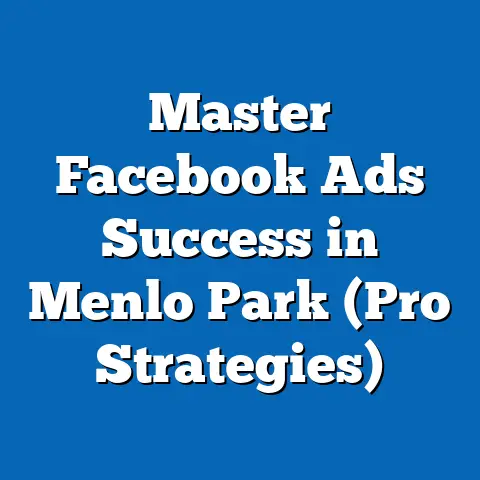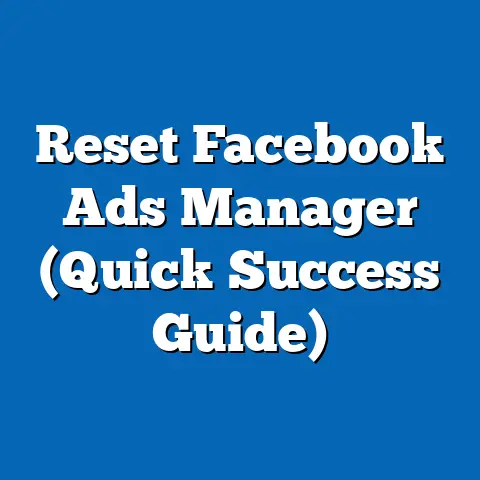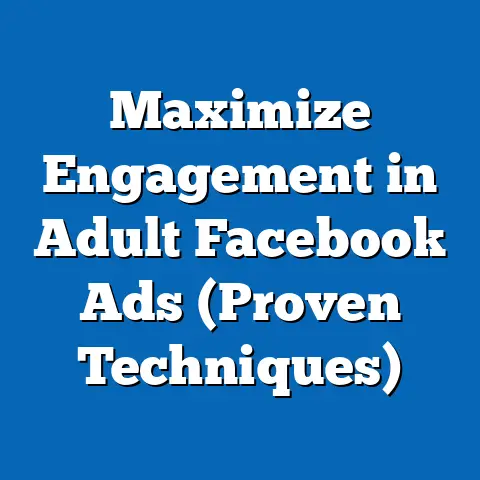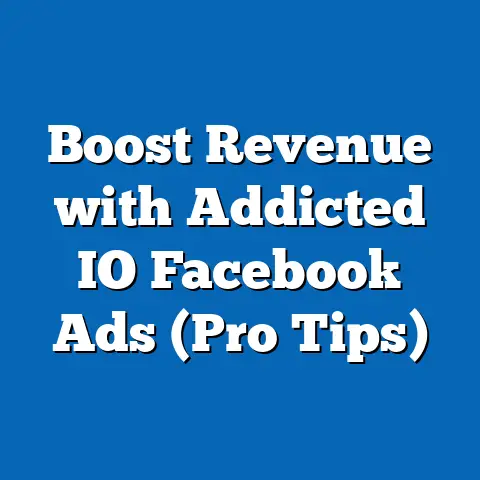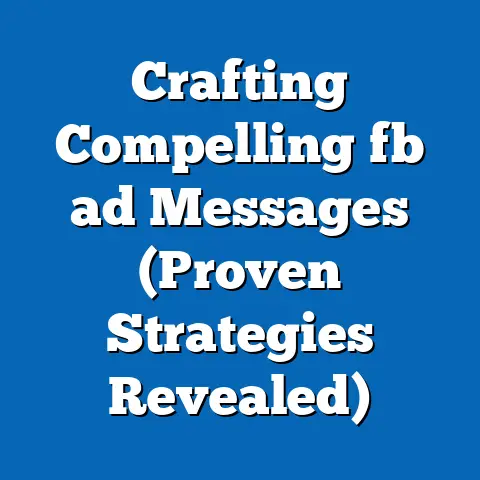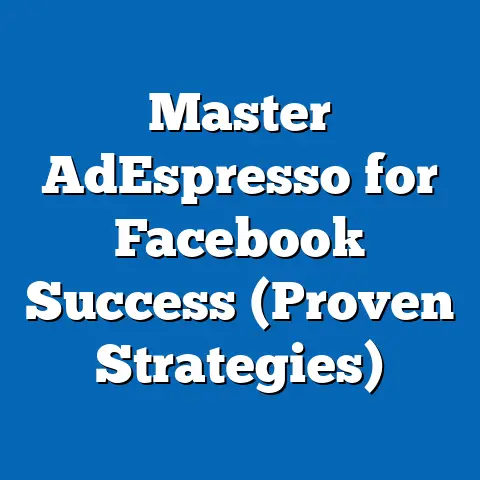Master the 388 Method for Facebook Ads (Unlock Revenue Growth)
Have you ever wondered why some businesses skyrocket their revenue through Facebook ads while others struggle to break even? The secret often lies not just in having a Facebook ad campaign, but in optimizing it for maximum impact. In today’s digital landscape, a well-crafted Facebook ad strategy is no longer optional – it’s essential. And that’s where the 388 Method comes in.
I’ve spent years navigating the ever-changing world of Facebook advertising, witnessing firsthand the strategies that work and those that fall flat. What I’ve found is that success isn’t about throwing money at the platform; it’s about a systematic, data-driven approach. The 388 Method is exactly that – a revolutionary approach designed to unlock significant revenue growth by focusing on key areas of your Facebook ad campaigns.
Understanding the 388 Method
The 388 Method is a strategic framework for optimizing Facebook ad campaigns to achieve substantial revenue growth. It’s not a magic bullet, but a structured approach that focuses on three critical elements: Targeting, Creative, and Optimization. The numbers “3,” “8,” and “8” represent the core principles within each of these areas.
Here’s a breakdown of what each number signifies:
- 3: Target Three Key Audience Segments: This emphasizes the importance of identifying and precisely targeting the most receptive audiences for your products or services. It’s about moving beyond broad demographics and delving into specific interests, behaviors, and custom audiences.
- 8: Create Eight Unique Ad Creatives: This highlights the need for diverse and engaging ad creatives. It’s not enough to have one or two ads; you need a variety of visuals, copy, and formats to capture attention and resonate with different audience segments. This also makes A/B testing more effective.
- 8: Implement Eight Key Optimization Techniques: This focuses on the ongoing refinement and improvement of your campaigns. It’s about constantly monitoring performance, adjusting budgets and bids, and leveraging Facebook’s powerful optimization tools to maximize your ROI.
The 388 Method isn’t just a random collection of numbers; it’s a holistic approach that aligns perfectly with how Facebook’s advertising algorithms work and how users interact with ads. The algorithm rewards relevant, engaging content that resonates with specific audiences. The 388 Method helps you create exactly that.
Relevance for Various Businesses:
The beauty of the 388 Method is its versatility. It’s applicable to a wide range of businesses, from small startups just finding their footing to established brands looking to scale their advertising efforts. Whether you’re selling e-commerce products, generating leads for a service business, or promoting a mobile app, the principles of the 388 Method can be adapted to your specific goals and target audience.
Takeaway: The 388 Method provides a clear framework for structuring your Facebook ad campaigns. By focusing on targeting, creative diversity, and continuous optimization, you can significantly improve your chances of achieving revenue growth.
The “3” in the 388 Method: Targeting Three Key Audience Segments
Effective targeting is the cornerstone of any successful Facebook ad campaign. You can have the most visually stunning ad in the world, but if it’s shown to the wrong people, it’s a wasted investment. The “3” in the 388 Method emphasizes the importance of identifying and targeting three key audience segments. I recommend starting with these three:
- Your Ideal Customer: This is your core audience – the people who are most likely to purchase your products or services. They often share common characteristics, interests, and pain points.
- Lookalike Audiences: These are audiences that Facebook creates based on your existing customer data. Facebook analyzes the characteristics of your best customers and finds other users who share similar traits.
- Retargeting Audiences: These are people who have already interacted with your business in some way, such as visiting your website, watching a video, or engaging with your Facebook page.
How to Identify and Analyze These Segments:
- Ideal Customer: Start by defining your ideal customer profile. What are their demographics (age, gender, location, education)? What are their interests, hobbies, and passions? What are their pain points and challenges? Use customer surveys, interviews, and website analytics to gather this information.
- Lookalike Audiences: To create lookalike audiences, you need to upload your existing customer data to Facebook. This can be in the form of a customer list (email addresses, phone numbers) or website visitor data (using the Facebook Pixel). Facebook will then create audiences that closely resemble your existing customers.
- Retargeting Audiences: The Facebook Pixel is essential for retargeting. It tracks the actions that people take on your website, allowing you to create custom audiences based on specific behaviors, such as viewing a product page, adding an item to their cart, or abandoning a checkout.
Actionable Tips for Creating Audience Personas:
- Give your personas names and faces: Humanizing your target audience makes it easier to understand their needs and motivations.
- Focus on their goals and challenges: What are they trying to achieve? What obstacles are they facing?
- Use real data to inform your personas: Don’t rely solely on assumptions. Use analytics and customer feedback to validate your assumptions.
Using Facebook’s Audience Insights Tool:
Facebook’s Audience Insights tool is a powerful resource for understanding your target audience. It provides detailed information about demographics, interests, behaviors, and page likes. You can use this tool to validate your audience personas, discover new interests, and identify potential targeting opportunities.
The Importance of Custom and Lookalike Audiences:
Custom and lookalike audiences are incredibly powerful because they allow you to target people who are most likely to be interested in your products or services. Custom audiences allow you to target your existing customers, while lookalike audiences allow you to expand your reach to new potential customers who share similar characteristics.
Real-World Examples:
- E-commerce: An online clothing store can target its ideal customer (women aged 25-45 interested in fashion and sustainable living), create a lookalike audience based on its existing customer list, and retarget website visitors who abandoned their shopping carts.
- Service Business: A local landscaping company can target homeowners in its service area, create a lookalike audience based on its existing customer base, and retarget website visitors who requested a quote.
- Mobile App: A mobile game developer can target users who have downloaded similar games, create a lookalike audience based on its existing player base, and retarget users who haven’t played the game in a while.
Takeaway: Precise targeting is essential for Facebook ad success. By focusing on your ideal customer, lookalike audiences, and retargeting audiences, you can ensure that your ads are seen by the people who are most likely to convert.
The “8” in the 388 Method – Creative Strategies
Once you’ve identified your target audiences, the next step is to create compelling ad creatives that capture their attention and drive engagement. The “8” in the 388 Method emphasizes the creation of eight unique ad creatives.
Why eight? Because variety is key. Different people respond to different types of visuals, copy, and formats. By creating a diverse range of ad creatives, you can increase your chances of finding the ones that resonate most effectively with your target audience. It also allows for more effective A/B testing.
The Significance of Ad Variety and A/B Testing:
- Ad Variety: Keeps your audience engaged and prevents ad fatigue. If people see the same ad over and over again, they’re likely to tune it out.
- A/B Testing: Allows you to compare different ad creatives and identify the ones that perform best. By testing different headlines, images, and calls-to-action, you can continuously optimize your ads for maximum impact.
Guidance on Types of Creatives:
- Images: High-quality, visually appealing images are essential for capturing attention. Use images that are relevant to your target audience and that showcase your products or services in the best possible light.
- Videos: Videos are incredibly engaging and can be used to tell a story, demonstrate a product, or provide valuable information. Keep your videos short and to the point, and make sure they’re optimized for mobile viewing.
- Carousels: Carousels allow you to showcase multiple products or features in a single ad. They’re a great way to tell a story or highlight different aspects of your business.
Best Practices for Each Creative Type:
- Images:
- Use high-resolution images that are visually appealing.
- Ensure the image is relevant to your product or service.
- Use clear and concise text overlays (if any).
- Test different image styles to see what resonates best with your audience.
- Videos:
- Keep your videos short and engaging (ideally under 30 seconds).
- Grab attention in the first few seconds.
- Use captions to make your videos accessible to viewers who have their sound off.
- Optimize your videos for mobile viewing (vertical format).
- Carousels:
- Use high-quality images or videos for each card in the carousel.
- Tell a story or highlight different aspects of your product/service across the cards.
- Include a clear call-to-action on each card.
- Test different card orders to see what drives the most engagement.
- Use high-resolution images that are visually appealing.
- Ensure the image is relevant to your product or service.
- Use clear and concise text overlays (if any).
- Test different image styles to see what resonates best with your audience.
- Keep your videos short and engaging (ideally under 30 seconds).
- Grab attention in the first few seconds.
- Use captions to make your videos accessible to viewers who have their sound off.
- Optimize your videos for mobile viewing (vertical format).
- Use high-quality images or videos for each card in the carousel.
- Tell a story or highlight different aspects of your product/service across the cards.
- Include a clear call-to-action on each card.
- Test different card orders to see what drives the most engagement.
The Importance of Compelling Copy and Strong Calls-to-Action (CTAs):
- Compelling Copy: Your ad copy should be clear, concise, and persuasive. It should highlight the benefits of your product or service and address the pain points of your target audience.
- Strong CTAs: Your call-to-action should tell people exactly what you want them to do. Use action-oriented words like “Shop Now,” “Learn More,” “Sign Up,” or “Get Started.”
Case Studies and Statistics:
- A/B Testing Example: A company ran two versions of an ad for a new product. Ad A featured a lifestyle image of a person using the product, while Ad B featured a product-focused image highlighting the key features. Ad B generated a 30% higher click-through rate and a 20% higher conversion rate.
- Video Ad Success: A brand launched a video ad campaign showcasing customer testimonials. The campaign resulted in a 40% increase in website traffic and a 25% increase in sales.
Takeaway: Don’t underestimate the power of creative diversity. By creating eight unique ad creatives and continuously A/B testing them, you can identify the winners that drive the best results for your business.
The Final “8” in the 388 Method – Optimization Techniques
Creating effective ads is just the beginning. The real magic happens when you continuously optimize your campaigns to maximize their performance. The final “8” in the 388 Method focuses on eight key optimization techniques for Facebook ads.
- Budget Allocation: Determine the right budget for each campaign and ad set based on your goals and target audience.
- Bidding Strategies: Choose the optimal bidding strategy (e.g., lowest cost, cost per result goal, value-based bidding) to achieve your desired results.
- Ad Scheduling: Schedule your ads to run during the times when your target audience is most active on Facebook.
- Placement Optimization: Optimize your ad placements (e.g., Facebook feed, Instagram feed, Audience Network) to reach your target audience where they’re most engaged.
- Audience Refinement: Continuously refine your target audiences based on performance data. Exclude underperforming segments and expand into new, relevant audiences.
- Creative Refresh: Regularly refresh your ad creatives to prevent ad fatigue and maintain audience engagement.
- Landing Page Optimization: Ensure your landing pages are optimized for conversions. Make sure they’re relevant to your ads, easy to navigate, and have clear calls-to-action.
- Performance Monitoring: Continuously monitor your ad performance metrics (e.g., reach, impressions, clicks, conversions, ROI) and make adjustments as needed.
Utilizing Facebook Pixel for Tracking Conversions and Retargeting:
The Facebook Pixel is a crucial tool for tracking conversions and retargeting. It allows you to see which ads are driving the most valuable actions on your website, such as purchases, sign-ups, or lead submissions. You can then use this data to optimize your campaigns and retarget people who have already interacted with your business.
Insights into the Importance of Ongoing Testing and Iteration:
Optimization is not a one-time task; it’s an ongoing process of testing and iteration. Continuously test different targeting options, ad creatives, and bidding strategies to identify what works best for your business. Use the data you gather to refine your campaigns and improve your results over time.
Success Stories and Testimonials:
- Case Study: A company implemented the 388 Method optimization techniques and saw a 50% increase in its return on ad spend (ROAS) within three months.
- Testimonial: “By continuously monitoring our ad performance and making data-driven adjustments, we were able to significantly improve our conversion rates and drive more sales.”
Takeaway: Optimization is the key to unlocking the full potential of your Facebook ad campaigns. By implementing these eight optimization techniques and continuously testing and iterating, you can maximize your ROI and achieve your business goals.
Conclusion
Mastering the 388 Method for Facebook ads is not just about understanding the principles; it’s about putting them into action. By focusing on targeting the right audiences, creating diverse and engaging ad creatives, and continuously optimizing your campaigns, you can transform your Facebook ads from a cost center to a powerful engine of revenue growth.
I’ve seen firsthand how this method can revolutionize businesses of all sizes. It’s not a quick fix, but a long-term strategy that requires dedication and a willingness to learn. But the rewards are well worth the effort.
I encourage you to adopt the 388 Method in your advertising strategies and to take action by implementing the insights shared throughout this article. Start by defining your ideal customer, creating a variety of ad creatives, and continuously monitoring your performance.
Remember, the power of effective Facebook advertising lies in its ability to connect you with the right people, at the right time, with the right message. By mastering the 388 Method, you can unlock that power and achieve unprecedented business success. So, go forth and conquer the world of Facebook advertising!

